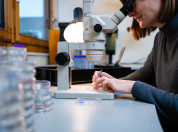Droevendaalsesteeg 10
6708 PB Wageningen
The Netherlands
I am fascinated by how organisms can cope with environmental change. In my PhD, I investigate the rapid adaptation to climate change of the winter moth: how was this species able to successfully adapt in just 10 years time?
In a world with rapid and wide-spread environmental changes, knowledge about how organisms can cope with these changes will be instrumental in making our society more sustainable.
My daily detective work at the NIOO involves investigating the winter moth's successful adaptation to climate change from different perspectives. In just 10 years, the seasonal timing of winter moth egg hatching relative to their food source improved. This shift involved genetic changes in how egg development responds to temperature during winter.
Using fluorescence imaging, gene expression profiling (RNAseq), whole-genome sequencing, and population modelling, I explore the what, when, and how of the winter moth's genetic adaptation to climate change.
How does winter moth egg development respond to temperature? What genes are involved in this response? What regions of the genome changed in response to selection from climate change? When did these changes take place?
By mastering lab techniques, bioinformatics, and statistics, and being the occasional control freak, I aim to answer these questions in my PhD project.
Publishing preprints is quickly becoming commonplace in ecology and evolutionary biology. Preprints can facilitate the rapid sharing of scientific knowledge establishing precedence and enabling feedback from the research community before peer review. Yet, significant barriers to preprint use exist, including language barriers, a lack of understanding about the benefits of preprints and a lack of diversity in the types of research outputs accepted (e.g. reports). Community-driven preprint initiatives can allow a research community to come together to break down these barriers to improve equity and coverage of global knowledge. Here, we explore the first preprints uploaded to EcoEvoRxiv (n = 1216), a community-driven preprint server for ecologists and evolutionary biologists, to characterize preprint use in ecology, evolution and conservation. Our perspective piece highlights some of the unique initiatives that EcoEvoRxiv has taken to break down barriers to scientific publishing by exploring the composition of articles, how gender and career stage influence preprint use, whether preprints are associated with greater open science practices (e.g. code and data sharing) and tracking preprint publication outcomes. Our analysis identifies areas that we still need to improve upon but highlights how community-driven initiatives, such as EcoEvoRxiv, can play a crucial role in shaping publishing practices in biology.
Climate change can severely impact species that depend on temporary resources by inducing phenological mismatches between consumer and resource seasonal timing. In the winter moth, warmer winters caused eggs to hatch before their food source, young oak leaves, became available. This phenological mismatch changed the selection on the temperature sensitivity of egg development rate. However, we know little about the fine-scale fitness consequences of phenological mismatch at the individual level and how this mismatch affects population dynamics in the winter moth. To determine the fitness consequences of mistimed egg hatching relative to timing of oak budburst, we quantified survival and pupation weight in a feeding experiment. We found that mismatch greatly increased mortality rates of freshly hatched caterpillars, as well as affecting caterpillar growth and development time. We then investigated whether these individual fitness consequences have population-level impacts by estimating the effect of phenological mismatch on population dynamics, using our long-term data (1994-2021) on relative winter moth population densities at four locations in The Netherlands. We found a significant effect of mismatch on population density with higher population growth rates in years with a smaller phenological mismatch. Our results indicate that climate change-induced phenological mismatch can incur severe individual fitness consequences that can impact population density in the wild.
Climate change will strongly affect the developmental timing of insects, as their development rate depends largely on ambient temperature. However, we know little about the genetic mechanisms underlying the temperature sensitivity of embryonic development in insects. We investigated embryonic development rate in the winter moth (Operophtera brumata), a species with egg dormancy which has been under selection due to climate change. We used RNA sequencing to investigate which genes are involved in the regulation of winter moth embryonic development rate in response to temperature. Over the course of development, we sampled eggs before and after an experimental change in ambient temperature, including two early development weeks when the temperature sensitivity of eggs is low and two late development weeks when temperature sensitivity is high. We found temperature-responsive genes that responded in a similar way across development, as well as genes with a temperature response specific to a particular development week. Moreover, we identified genes whose temperature effect size changed around the switch in temperature sensitivity of development rate. Interesting candidate genes for regulating the temperature sensitivity of egg development rate included genes involved in histone modification, hormonal signalling, nervous system development and circadian clock genes. The diverse sets of temperature-responsive genes we found here indicate that there are many potential targets of selection to change the temperature sensitivity of embryonic development rate. Identifying for which of these genes there is genetic variation in wild insect populations will give insight into their adaptive potential in the face of climate change.


